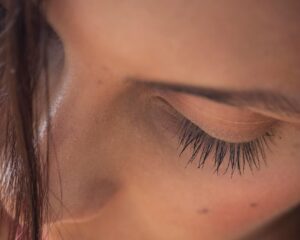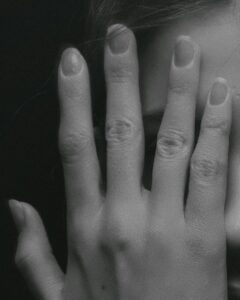Like most people, you have probably occasionally played with your hair or scratched at a mosquito bite. You’ve probably also picked at a scab or even picked your nose— these are normal, human habits. These behaviors are nothing unusual and most people periodically engage in these actions. Sometimes, though, people engage in these behaviors in a more chronic way. They might twirl their hair and then pull it out. Or, they may scratch or pick at their skin so frequently that it takes up a significant amount of time during the day. When behaviors like skin picking or hair pulling are performed repeatedly like this it may be considered a body-focused repetitive behavior (BFRB).
What are BFRBs?
Anyone can be affected by a BFRB, however, they are more commonly diagnosed in women. The behaviors typically become prevalent enough to be diagnosed at some point during adolescence.
BFRBs are a group of conditions that can include habits like persistent nail biting, nose picking and cheek or lip biting.
There are two commonly known types of BFRBs. One of the most common forms is hair pulling (i.e. trichotillomania or “trich”) which can affect the scalp, eyelashes, eyebrows, and facial hair. Another common BFRB is skin picking (i.e. dermatillomania or excoriation disorder) which can affect skin on any part of the body, including the face and scalp. These diagnoses may also be co-occurring with OCD and/or anxiety disorders.
Myths and Misconceptions About BFRBs
Unfortunately there are many myths and misconceptions about why people may engage in the pulling or picking habits associated with BFRBs. It’s important to understand that BFRBs are not done to gain attention, and they are not self-harming behaviors. Both BFRBs and self-injurious behaviors have a connection to stress, but their function is different.
When it comes to BFRBs, injury may be a result of the hair pulling or skin picking behavior, but it is not the goal. Picking and pulling habits are not done to relieve stress or suffering from a bad day in the same way that cutting may be performed. Oftentimes BFRBs are sensory-related and performed because something feels “out of place.” BFRBs are not related to trauma or self-worth, they are simply habits that are reinforced the more times they are performed.
When to Seek Treatment for BFRBs
BFRBs can start out as normal behaviors that any person engages in from time to time. However, once these behaviors become more intense and frequent— particularly to the point at which they start to negatively interfere with a person’s life— it may be time to seek help from a psychologist. An interference might look like:
- Excessive Time Spent. Someone may spend so much time engaging in a pulling or picking habit (> 20min) that they spend less time on other things like school, work, or hobbies. They may be so preoccupied with these behaviors that they run late to an important meeting or miss out on other experiences.
- Social Withdrawal. BFRBs can result in noticeable wounds or bald spots. As a result they may spend less time with friends or family for fear of how they will be perceived.
- Resulting Medical Issues. Serious cases of skin picking present a risk of infection if the wounds are not properly cared for. In trichotillomania it is not uncommon that a person may ingest the hair they have pulled. In some cases this can lead to a ball of hair in the stomach, known as a trichobezoar, which is a serious gastrointestinal health risk.
- Poor Self Image. These factors combined can heighten feelings of shame and reduce a person’s feelings of worth. This can lead to negative perception of self as well as lowered mood and frustration.
All of these experiences can have an adverse effect on someone’s quality of life and their happiness, which are strong signs that it may be time to seek professional support. The symptoms of trichotillomania and dermatillomania can wax and wane over time, but if left untreated these can become chronic and persistent conditions. Therapy to address these behaviors has been proven to help reduce symptoms of BFRBs, and treatment can be particularly effective for children and adolescents. BFRBs can be more difficult to treat in adults, especially those with longstanding pulling and/or picking habits, so early intervention can be helpful.
How Are BFRBs Treated?
Trichotillomania, dermatillomania, and other BFRBs are treatable and can be stopped. The recommended treatment is habit reversal training, which is used to reduce unwanted behaviors by replacing them with other actions. Derivative treatments are clinically recommended and widely used to address other concerns, such as tics and Tourette syndrome.
HRT is an evidence-based treatment that outlines five core steps to help reduce BFRBs:
- Education. Picking and pulling behaviors are often performed to help someone ease feelings of discomfort, but in turn, the result of those behaviors (e.g. wounds, bald spots) can result in even more distress. By understanding this cycle, individuals can better curb the behaviors. HRT teaches individuals how to sit with the urge to pick or pull without acting on it. It may be uncomfortable at first, but in time the urges will decrease so that the cycle can be broken and the behaviors can be controlled.
- Functional Assessment + Self Monitoring. This step focuses on helping individuals recognize the different factors that might intensify or reduce their pulling or picking behaviors. There may be certain environments, emotions, or even times of day connected to the behavior. Identifying these situations and “triggers” can allow someone to recognize a behavioral pattern and develop more effective strategies in response.
- Awareness Training. The knowledge gained about one’s behaviors can be used not just to become aware of when they are engaging in picking or pulling, but to increase awareness about the urges that precede them. Recognizing when the desire to pick or pull is present, along with what causes that urge, is a critical step. This helps individuals learn to be proactive in stopping the behavior before it happens.
- Stimulus Control. Once someone understands the cycle of behaviors they can learn how to interrupt the flow of the picking or pulling habits. For example, someone might wear a hat so that they don’t pull their hair, or wear gloves so that they cannot easily pick or scratch. This doesn’t necessarily stop the behavior, but it does interrupt the cycle of the habit to create more awareness that it is happening.
- Competing Response Training. Even with prevention efforts there may still be strong urges to pick or pull. This step teaches effective strategies that can be used across all situations that are socially acceptable. Applying a competing strategy (e.g. instead of scratching at your face, you cross your arms) can reduce how frequently someone acts on the urge to pull or pick.
Depending on the needs of the person struggling with the BFRB a psychologist may customize this approach to include additional therapeutic elements. This can help target related challenges so that individuals can effectively work to achieve their treatment goals. Another approach that may be used is the ComB treatment, which helps individuals more fully understand what contributes to their habitual behaviors.
Supporting Those with BFRBs
Social support plays a crucial role in the success of treatment throughout these steps. For children and adolescents in therapy to address trichotillomania or dermatillomania, parents can also learn skills to help their child reduce their picking or pulling habits. Parents may get frustrated with their child’s BFRB and not understand why they continue to engage in the habit. When this frustration is expressed to a child in an effort to make them stop, it can actually increase the frequency of the behaviors.

Instead of pointing out the behavior directly, supporters can use it as an opportunity to help reinforce the strategies that are being taught in therapy. Approaching the subject in a more mindful and less critical way can help your loved on feel supported and more receptive to your suggestions. Supporters can act as “coach” to help their loved one with monitoring their behaviors. Gently pointing out that the behavior is occurring and how they can resist the urge (e.g. “I am noticing your hands are by your face, what are some of the strategies you have been practicing?”) can help bring awareness to the habit without contributing to feelings of shame or distress.
Finding Relief from BFRBs
Even those who have struggled with a BFRB for an extended period of time are encouraged to seek out the support of a mental health professional. Working with someone trained in treating hair pulling, skin picking, and related challenges can offer the necessary support and guidance to help you learn how to reduce the frequency and severity of the behaviors. A psychologist trained in cognitive behavior therapy (CBT) who specializes in treating BFRBs can help you or your loved one learn strategies to manage the behaviors and find relief.


